Click on images to enlarge
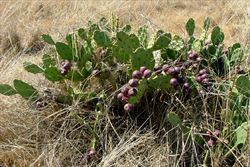
habit in fruit (Photo: Sheldon Navie)

habit in flower (Photo: Sheldon Navie)
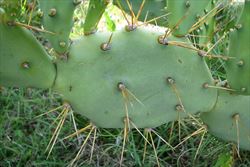
stem segment with spines (Photo: Sheldon Navie)
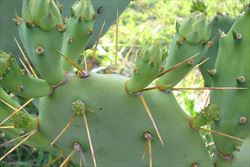
flower buds and young stem segment with tiny leaves (Photo: Sheldon Navie)

flowers (Photo: Sheldon Navie)

close-up of flower (Photo: Sheldon Navie)
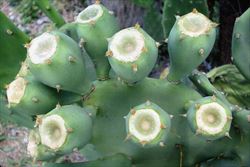
immature fruit (Photo: Sheldon Navie)
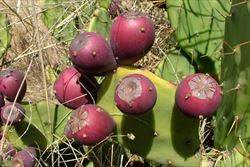
mature fruit (Photo: Sheldon Navie)

close-up of mature fruit (Photo: Sheldon Navie)

close-up of seeds (Photo: Carole Ritchie at USDA PLANTS Database)

young plant (Photo: Sheldon Navie)
Scientific Name
Opuntia dillenii (Ker-Gawl.) Haw.
Synonyms
Cactus dillenii Ker-Gawl.Opuntia stricta (Haw.) Haw. var. dillenii (Ker-Gawl.) L. Benson
Family
Cactaceae
Common Names
Australian pest pear, common prickly pear, Dillen's prickly pear, Eltham Indian fig, erect prickly pear, Gayndah pear, pipestem prickly pear, prickly pear, sour prickly pear, spiny pest pear, spiny pest-pear, sweet prickly pear, sweet prickly-pear.
Origin
Native to south-eastern USA (i.e. Alabama, Florida, Georgia, South Carolina and Texas), Mexico, Central America, the Caribbean and parts of northern South America (i.e. Ecuador).
Naturalised Distribution
This species is naturalised in the eastern parts of Australia, and once infested very large areas. It has been recorded in southern and central Queensland and in some parts of New South Wales. However, its current distribution may be underestimated because it is easily mistaken for common prickly pear (Opuntia stricta).
Also naturalised in South Africa and on the Galapagos Islands.
Habitat
A weed of semi-arid, sub-tropical, tropical and warmer temperate regions. It may inhabit open woodlands, rangelands, grasslands, pastures, creekbanks, roadsides, railways lines, coastal environs, gardens, disturbed sites and waste areas.
Habit
An upright (i.e. erect) or more often spreading, fleshy (i.e. succulent), plant usually growing 50-100 cm tall, but occasionally reaching up to 2 m in height.
Distinguishing Features
- an upright or spreading, fleshy plant usually growing 50-100 cm tall.
- its stems are much-branched and consist of a series of flattened, fleshy segments.
- these segments are longer than they are broad and sparsely covered in groups of 1-7 sharp spines (2-4 cm long).
- its showy yellow flowers (6-8 cm across) are borne along the margins of the stem segments.
- its fleshy fruit have several tufts of small barbed bristles on their surface and turn reddish-purple as they mature.
Stems and Leaves
The stems are much-branched and consist of a series of flattened fleshy (i.e. succulent) segments, which are sometimes confused for leaves. These segments (10-40 cm long, 5-20 cm wide and 1-2 cm thick) are green or bluish-green in colour and longer than they are broad (i.e. elliptic or obovate in shape). They are hairless (i.e. glabrous) and covered in small raised bumps (i.e. areoles) which bear tiny spiny bristles (i.e. glochids). Most of these small raised bumps (i.e. areoles) also have 1-7 larger sharp spines (2-4 cm long).
The leaves are reduced to small, slightly curved, cone-shaped (i.e. conical) structures (up to 6 mm long) and are quickly shed (i.e. they are caducous).
Flowers and Fruit
The flowers (up to 7 cm long and 6-8 cm across) are bright yellow and sometimes have greenish or pinkish coloured markings on the outer 'petals'. They are borne singly on fleshy bases and are mostly found along the margins of the stem segments. These flowers have numerous 'petals' (most of these are actually petal-like structures known as petaloids), 25-50 mm long, and numerous stamens. Flowering occurs mostly during spring and summer.
The immature fruit are green, but they turn reddish-purple in colour as they mature. These fruit (4-9 cm long and 3-4 cm wide) are fleshy (i.e. succulent), pear-shaped (i.e. pyriform) or almost rounded (i.e. globose), berries. They may have a shallow depression at the top, especially when they are young, and always have several tufts of small barbed bristles (i.e. glochids) on their surface. The reddish or purplish coloured pulp in the centre of the fruit contains large numbers of seeds. These seeds (4-5 mm long and 4-4.5 mm wide) are generally yellow or pale brown in colour and somewhat rounded (i.e. sub-globose) in shape.
Reproduction and Dispersal
This plant reproduces by seed and also vegetatively via its fleshy (i.e. succulent) stem fragments (i.e. the stem segments may become dislodged and develop into new plants).
Stem fragments are spread by becoming attached to animals, footwear and vehicles. They are also dispersed in floodwaters and dumped garden waste. The fruit are eaten by various animals (e.g. birds and foxes) and the seeds then spread in their droppings.
Environmental Impact
Spiny pest pear (Opuntia dillenii) is regarded as an environmental weed in Queensland and New South Wales. It is also listed in the Global Invasive Species Database, and is regarded to be in the top 100 of the world’s worst invasive alien species.
Legislation
This species is declared under legislation in the following states and territories:
- New South Wales: Class 4 - a locally controlled weed. The growth and spread of this species must be controlled according to the measures specified in a management plan published by the local control authority and the plant may not be sold, propagated or knowingly distributed (throughout the entire state). This declaration also applies to all prickly pears (i.e. Opuntia spp.), except Indian fig (i.e. Opuntia ficus-indica).
- Northern Territory: B - growth and spread of this species to be controlled (south of 18°S latitude, in areas outside of towns), and C - not to be introduced into the Territory. This declaration also applies to all prickly pears (i.e. Opuntia spp.).
- Queensland: Class 2 - landowners must take all reasonable steps to keep land free of this species (throughout the entire state). It is also illegal to sell a declared plant or its seed in this state. This declaration also applies to all prickly pears (i.e. Opuntia spp.), except Indian fig (i.e. Opuntia ficus-indica).
- South Australia: 1@ - this species is declared under Class 1c, a classification for prohibited terrestrial plants. It is declared, and its control is required, throughout the entire state. This declaration also applies to all prickly pears (i.e. Opuntia spp.), except Indian fig (i.e. Opuntia ficus-indica).
- Western Australia: P1 - the movement of this species or its seeds is prohibited (for all local authority areas in that part of the state north of the 26th parallel of latitude), P2 - to be eradicated (for all local authority areas in that part of the state north of the 26th parallel of latitude, except for the Exmouth, Carnarvon, Murchison, Upper Gascoyne and Shark Bay local authority areas), and P4 - it must be 'contained' (in the Exmouth, Carnarvon, Murchison, Upper Gascoyne and Shark Bay local authority areas). This declaration also applies to all prickly pears (i.e. Opuntia spp.).
Management
For information on the management of this species see the following resources:
- the Biosecurity Queensland Fact Sheet on prickly pear identification and control, which is available online at http://www.dpi.qld.gov.au.
- the Northern Territory Department of Natural Resources, Environment and The Arts Agnote on this species, which is available online at http://www.nt.gov.au/weeds.
Similar Species
Spiny pest pear (Opuntia dillenii) is very similar to common prickly pear (Opuntia stricta) and intermediates between the two species are sometimes seen in Australia. It is also similar to Indian fig (Opuntia ficus-indica), white-spined prickly pear (Opuntia streptacantha), drooping tree pear (Opuntia monacantha) and velvety tree pear (Opuntia tomentosa). These species can be distinguished by the following differences:
- spiny pest pear (Opuntia dillenii) is a low-growing plant (usually 50-100 cm tall) with relatively large flattened and elongated (i.e. elliptic or obovate) stem segments. These stem segments are hairless and have groups of 1-7 large spines on most of the small raised bumps (i.e. areoles) on their surfaces. The flowers are bright yellow and the fruit reddish-purple.
- common prickly pear (Opuntia stricta) is a low-growing plant (usually 50-100 cm tall) with relatively large flattened and elongated (i.e. elliptic or obovate) stem segments. These stem segments are hairless and generally do not have any spines (sometimes one or two large spines are present) on the small raised bumps (i.e. areoles) on their surfaces. The flowers are bright yellow and the fruit reddish-purple.
- Indian fig (Opuntia ficus-indica) is a relatively tall shrubby or tree-like plant (usually 1.5-3 m tall) with very large flattened and elongated (i.e. oblong, elliptic or obovate) stem segments. These stem segments are hairless and do not have any spines on the small raised bumps (i.e. areoles) on their surfaces. It has yellow flowers and reddish or pinkish coloured fruit.
- white-spined prickly pear (Opuntia streptacantha) is a relatively tall and sometimes tree-like plant (usually 2-4 m tall) with flattened and egg-shaped (i.e. obovate) to almost circular (i.e. orbicular) stem segments. These stem segments are hairless and have groups of 3-20 small white spines on most of the small raised bumps (i.e. areoles) on their surfaces. It has yellow flowers and dull red or yellowish coloured fruit.
- drooping tree pear (Opuntia monacantha) is a relatively tall shrub or tree-like plant (usually 2-5 m tall) with flattened and elongated (i.e. oblong or obovate) stem segments. These stem segments are hairless and have one or two large spines on most of the small raised bumps (i.e. areoles) on their surfaces. It has yellow flowers and reddish-purple fruit, and some of its stem segments usually droop towards the ground during fruiting.
- velvety tree pear (Opuntia tomentosa ) is a tall plant that is tree-like in appearance (up to 6 m tall) with flattened and elongated (i.e. oblong or elliptic) stem segments. These stem segments are velvety hairy (i.e. finely pubescent) and do not have any spines on the small raised bumps (i.e. areoles) on their surfaces. It has bright orange flowers and reddish-purple fruit.

